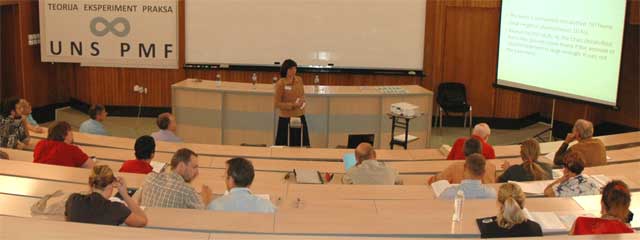LOESSFEST'09 | Aug. 31st – Sept. 3rd, 2009 |Novi Sad-Serbia
New Study of an Upper Pleistocene Loess Locality Located in Northern Brittany (France) – Preliminary Results
Danukalova G.A.1, Lefort J.P.2
1Institution Russian Academy of Sciences Institute of geology of the Ufimian scientific centre.450077, Ufa. K. Marx Str. 16/2. Russia
2Université de Rennes 1, Campus de Beaulieu, Laboratoire d’Archéosciences (bât. 24- 25),74205 CS, 35042 Rennes cedex. France
The La Haute Ville site is characterized by thick loess deposits, it is located in the surroundings of Pleneuf-Val-Andre and Port-Morvan villages in the St Brieuc Bay (Brittany, France). This cliff was first investigated by Y. Beigbeder (1964), by J-L. Monnier (1980), and by J-L. Monnier and B. Van Vliet-Lanoë (1986). Since the first study the outcrop has been deeply modified because of the sea abrasion which removed about four meters of cliff sediments. In the present work we will describe the cliff deposits following the general description given by J.-L. Monnier (1980) but modified by the authors observations:
- Brown loam with gravels and boulders (coarse-grained colluvium) (Thickness: 2 m).
- Light grey loam (fine-grained colluvium) (Thickness: 0,3 m).
- Sandy loam with layer of small boulders and shell fragments (Thickness: 3 m).
Pleistocene Last Glaciation (18000-20000 y. BP) - Light brown dense loam with plant roots (Thickness: 0,6 m). Sample 1 (base).
- Light brown carbonaceous loam (loess) (Thickness:1,4 m). Samples 2-5.
- Boulders with yellowish brown loam and sandy cement with pebble (Thickness: 0,2 m). Weichselian Upper Pleniglacial (20000-80000 y. BP)
- Brown loam with carbonaceous concretions.
- Brownish yellow massive loam with pebbles interlayers and concretions (Thickness: 0,4 m). Sample 6.
- Boulders with pieces of marine shells (Thickness: 0,1 m).
- Light brown loam, sandy loam with fauna remains (Thickness: 0,5 m).
- Brown loam with land mollusk shells, pieces of marine shells, holes of rodents
(Thickness: 0,1 m).
Erosion limit.
Samples 7 to12 were taken from layers 9 to 11.
End of Eemian (MIS 5 a-b?) - Brown sandy humic loam (Thickness: 0,1 m). Sample 13.
- Brown and dark brown sandy loam with angulated pebble and boulders (Thickness: 0,8 m). Sample 14.
- Traces of erosion.
Middle of Eemian (MIS 5 c?) - Brown ferruginated sand (soil above the ancient dune) (Thickness: 0,8 m).
- Yellowish brown sand with layers of different color.
- Reddish, yellowish brown thin-grained sand (ancient dune) (Thickness: 8 m).
- Sand with ferruginization and wavy manganese oxide layers.
- Traces of erosion.
- Grey sand with manganese oxide.
- Yellowish brown and yellowish red loam (Thickness: 0,5 m).
- Black boundary.
Samples 15 was taken from the middle of the dune, sample 16 – from the lower part of the dune.
Beginning of Eemian (?) - Solifluction horizon and marine sand with boulders.

Erosional basement
Samples for molluscs study were taken from the loess deposits. One sample was approximately equal to 10 kg of unconsolidated deposits. The soil was taken from excavation pit in splits of 0,5 m (samples 1 to 5), 0,20 m (samples 6 to14) and 1m (samples 15 to 16) and then washed using sieves of 1,0 mm. Work on the loess molluscs investigations is continuing. This site was shown to the participants of the INQUA SEQS conference in 2008. Sites which contain remnants of mollusc shells incorporated in thick loess deposits are not many in northern Brittany because of a secondary processes of decalcification. The deposits of La Haute Ville locality will be also studied by specialists in palynology and dating.



